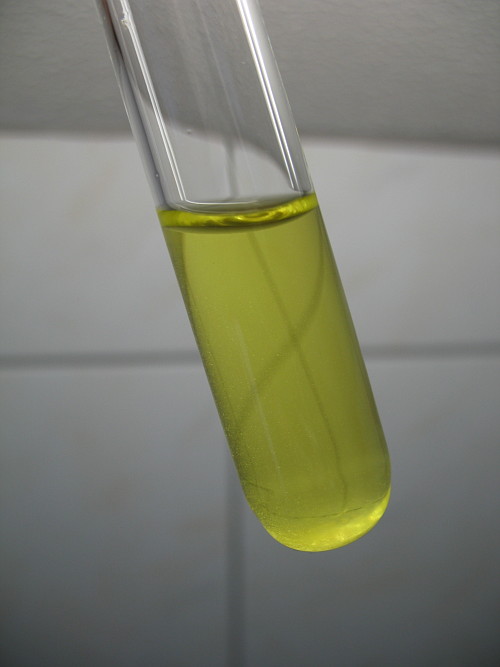


Magnetic properties of magnetite
In this experiment a mixed oxidation state precipitate of iron is made, which is ferrimagnetic (not to be confused with ferromagnetic). The experiment is very simple, but the effect really is striking.
Only very mundane chemicals are needed and a strong magnet.
![]()
![]() Required
chemicals:
Required
chemicals:
-
ferric chloride (or any other iron(III) salt)
-
ferrous sulfate (or any other iron(II) salt)
-
dilute hydrochloric acid (5% HCl by weight)
-
dilute ammonia (household ammonia 5% NH3 by weight is suitable)
![]() Required
equipment:
Required
equipment:
-
test tubes
-
medium strength neodymium magnet
![]() Safety:
Safety:
-
Hydrochloric acid and ammonia at the given concentrations are somewhat corrosive. In case of contact, rinse with cold water.
-
Neodymium magnets are remarkably strong. For this experiment only medium ones of approximately 1 cm sizes are needed. The big ones are really dangerous and should not be handled by inexperienced people.
![]() Disposal:
Disposal:
- After the reaction, add some dilute hydrochloric acid to dissolve remains of the precipitate. The final waste can be flushed down the drain with lots of water. The waste is not particularly toxic.
![]()
Preparation of a solution with iron(II) and iron(III) ions
![]() Take a
small granule of ferric chloride (PCB etchant chemical available from
electronics shops) and add this to 2 ml of dilute hydrochloric acid.
Take a
small granule of ferric chloride (PCB etchant chemical available from
electronics shops) and add this to 2 ml of dilute hydrochloric acid.
![]() In
another test tube, dissolve some ferrous sulfate in some water.
In
another test tube, dissolve some ferrous sulfate in some water.
![]() Mix the
two liquids. A yellow solution is obtained. The color of this solution is due to
the presence of FeCl4– ions, a complex formed from
chloride and iron(III) ions. With the technical grade chemicals used in this
experiment (PCB etchant and potteries grade ferrous sulfate) no truly clear
liquid is obtained, but that does not matter.
Mix the
two liquids. A yellow solution is obtained. The color of this solution is due to
the presence of FeCl4– ions, a complex formed from
chloride and iron(III) ions. With the technical grade chemicals used in this
experiment (PCB etchant and potteries grade ferrous sulfate) no truly clear
liquid is obtained, but that does not matter.

![]()
Preparation of impure magnetite
To the solution as described above, very carefully add a large excess of clear ammonia (5% by weight, clear household ammonia is perfectly suitable). This results in formation of an almost black precipitate of magnetite. If the ammonia is poured on the yellow liquid very carefully, then the liquids do not mix immediately, but the ammonia (which has lower density) remains in the top of the test tube. The result looks as follows:

The precipitate is brown and not purely black. It is not pure magnetite, apparently there was some excess of ferric chloride and a mix of ferric hydroxide and magnetite is produced, which is dark brown (pure magnetite looks more blue/black). For this experiment it does not matter if the magnetite precipitate is impure.
![]()
Action of strong magnet on precipitate
Now the most interesting part of the experiment can be done. Take a medium strength neodymium magnet (cube or block of 1 cm or a pile of smaller magnets, such that the total size is 1 to 1.5 cm). For this experiment, a pile of smaller magnets was used, a single larger magnet was not available. The picture below shows the size of the pile of magnets, related to a coin of 50 euro cents.

Move the magnet around the test tube. The precipitate follows the magnet while is it moved around the test tube.



The effect is best demonstrated by a video: magnetite attracted by magnet. Download size is approximately 7 MByte. Unfortunately the image quality only is moderate (due to required strong zooming of digital camera), but the video nevertheless nicely demonstrates the effect.
![]()
Discussion of results
![]() When a base is added to a solution, containing both iron(II) ions and iron(III)
ions, then the mixed oxidation state oxide Fe3O4
is produced. This is a dark black compound with a blue hue.
When a base is added to a solution, containing both iron(II) ions and iron(III)
ions, then the mixed oxidation state oxide Fe3O4
is produced. This is a dark black compound with a blue hue.
Fe2+ + 2Fe3+ + 8OH– → Fe3O4 + 4H2O
In this experiment, the hydroxide comes from the ammonia:
NH3 + H2O ↔ NH4+ + OH–
Besides the compound Fe3O4 also Fe(OH)3 is formed in this experiment and this makes the precipitate look brown instead of black/blue.
![]() The compound Fe3O4
has easily observable magnetic properties and for this reason it is called
magnetite. The material is ferrimagnetic.
Ferrimagnetism
mainly is exhibited by
magnetic
oxides known as ferrites. The best known example of such a material is the
naturally occurring magnetite. This compound contains negative oxygen ions O2-
and positive iron ions in two oxidation states, iron(II) ions, Fe2+,
and iron(III) ions, Fe3+. The oxygen
ions do not have any magnetic properties, but both iron ions have. In magnetite
crystals, the iron(III) ions are pairwise oriented in opposite directions,
producing no external
magnetic
field, but the iron(II) ions are all aligned in the same direction, resulting in
external magnetism.
The compound Fe3O4
has easily observable magnetic properties and for this reason it is called
magnetite. The material is ferrimagnetic.
Ferrimagnetism
mainly is exhibited by
magnetic
oxides known as ferrites. The best known example of such a material is the
naturally occurring magnetite. This compound contains negative oxygen ions O2-
and positive iron ions in two oxidation states, iron(II) ions, Fe2+,
and iron(III) ions, Fe3+. The oxygen
ions do not have any magnetic properties, but both iron ions have. In magnetite
crystals, the iron(III) ions are pairwise oriented in opposite directions,
producing no external
magnetic
field, but the iron(II) ions are all aligned in the same direction, resulting in
external magnetism.
It is essential that both iron(II) and iron(III) are present in the crystal lattice. For this reason, both an iron(II) salt and an iron(III) salt are used in the experiment.